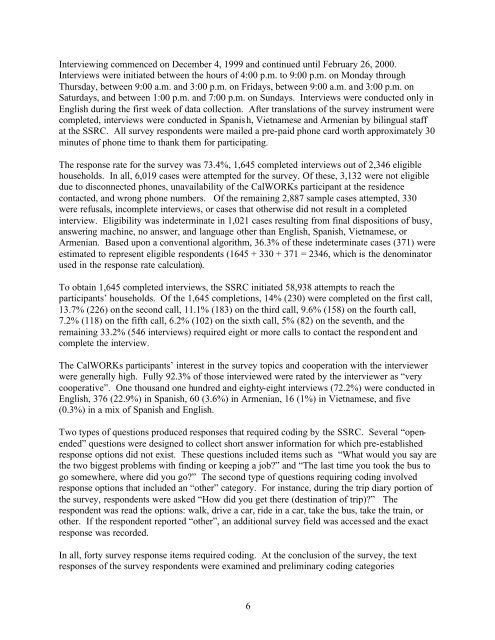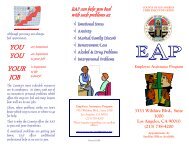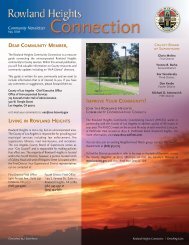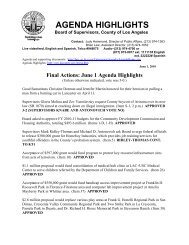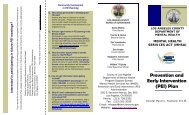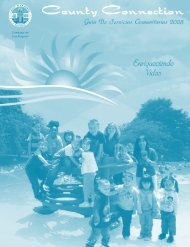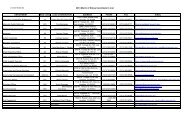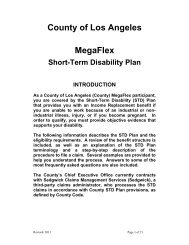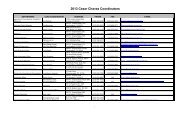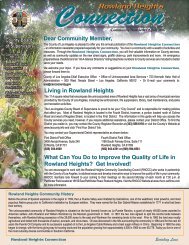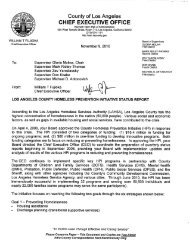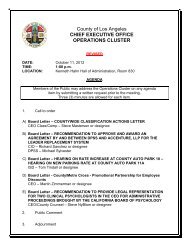assessing the transportation needs of welfare-to-work participants in ...
assessing the transportation needs of welfare-to-work participants in ...
assessing the transportation needs of welfare-to-work participants in ...
Create successful ePaper yourself
Turn your PDF publications into a flip-book with our unique Google optimized e-Paper software.
Interview<strong>in</strong>g commenced on December 4, 1999 and cont<strong>in</strong>ued until February 26, 2000.<br />
Interviews were <strong>in</strong>itiated between <strong>the</strong> hours <strong>of</strong> 4:00 p.m. <strong>to</strong> 9:00 p.m. on Monday through<br />
Thursday, between 9:00 a.m. and 3:00 p.m. on Fridays, between 9:00 a.m. and 3:00 p.m. on<br />
Saturdays, and between 1:00 p.m. and 7:00 p.m. on Sundays. Interviews were conducted only <strong>in</strong><br />
English dur<strong>in</strong>g <strong>the</strong> first week <strong>of</strong> data collection. After translations <strong>of</strong> <strong>the</strong> survey <strong>in</strong>strument were<br />
completed, <strong>in</strong>terviews were conducted <strong>in</strong> Spanish, Vietnamese and Armenian by bil<strong>in</strong>gual staff<br />
at <strong>the</strong> SSRC. All survey respondents were mailed a pre-paid phone card worth approximately 30<br />
m<strong>in</strong>utes <strong>of</strong> phone time <strong>to</strong> thank <strong>the</strong>m for participat<strong>in</strong>g.<br />
The response rate for <strong>the</strong> survey was 73.4%, 1,645 completed <strong>in</strong>terviews out <strong>of</strong> 2,346 eligible<br />
households. In all, 6,019 cases were attempted for <strong>the</strong> survey. Of <strong>the</strong>se, 3,132 were not eligible<br />
due <strong>to</strong> disconnected phones, unavailability <strong>of</strong> <strong>the</strong> CalWORKs participant at <strong>the</strong> residence<br />
contacted, and wrong phone numbers. Of <strong>the</strong> rema<strong>in</strong><strong>in</strong>g 2,887 sample cases attempted, 330<br />
were refusals, <strong>in</strong>complete <strong>in</strong>terviews, or cases that o<strong>the</strong>rwise did not result <strong>in</strong> a completed<br />
<strong>in</strong>terview. Eligibility was <strong>in</strong>determ<strong>in</strong>ate <strong>in</strong> 1,021 cases result<strong>in</strong>g from f<strong>in</strong>al dispositions <strong>of</strong> busy,<br />
answer<strong>in</strong>g mach<strong>in</strong>e, no answer, and language o<strong>the</strong>r than English, Spanish, Vietnamese, or<br />
Armenian. Based upon a conventional algorithm, 36.3% <strong>of</strong> <strong>the</strong>se <strong>in</strong>determ<strong>in</strong>ate cases (371) were<br />
estimated <strong>to</strong> represent eligible respondents (1645 + 330 + 371 = 2346, which is <strong>the</strong> denom<strong>in</strong>a<strong>to</strong>r<br />
used <strong>in</strong> <strong>the</strong> response rate calculation).<br />
To obta<strong>in</strong> 1,645 completed <strong>in</strong>terviews, <strong>the</strong> SSRC <strong>in</strong>itiated 58,938 attempts <strong>to</strong> reach <strong>the</strong><br />
<strong>participants</strong>’ households. Of <strong>the</strong> 1,645 completions, 14% (230) were completed on <strong>the</strong> first call,<br />
13.7% (226) on <strong>the</strong> second call, 11.1% (183) on <strong>the</strong> third call, 9.6% (158) on <strong>the</strong> fourth call,<br />
7.2% (118) on <strong>the</strong> fifth call, 6.2% (102) on <strong>the</strong> sixth call, 5% (82) on <strong>the</strong> seventh, and <strong>the</strong><br />
rema<strong>in</strong><strong>in</strong>g 33.2% (546 <strong>in</strong>terviews) required eight or more calls <strong>to</strong> contact <strong>the</strong> respondent and<br />
complete <strong>the</strong> <strong>in</strong>terview.<br />
The CalWORKs <strong>participants</strong>’ <strong>in</strong>terest <strong>in</strong> <strong>the</strong> survey <strong>to</strong>pics and cooperation with <strong>the</strong> <strong>in</strong>terviewer<br />
were generally high. Fully 92.3% <strong>of</strong> those <strong>in</strong>terviewed were rated by <strong>the</strong> <strong>in</strong>terviewer as “very<br />
cooperative”. One thousand one hundred and eighty-eight <strong>in</strong>terviews (72.2%) were conducted <strong>in</strong><br />
English, 376 (22.9%) <strong>in</strong> Spanish, 60 (3.6%) <strong>in</strong> Armenian, 16 (1%) <strong>in</strong> Vietnamese, and five<br />
(0.3%) <strong>in</strong> a mix <strong>of</strong> Spanish and English.<br />
Two types <strong>of</strong> questions produced responses that required cod<strong>in</strong>g by <strong>the</strong> SSRC. Several “openended”<br />
questions were designed <strong>to</strong> collect short answer <strong>in</strong>formation for which pre-established<br />
response options did not exist. These questions <strong>in</strong>cluded items such as “What would you say are<br />
<strong>the</strong> two biggest problems with f<strong>in</strong>d<strong>in</strong>g or keep<strong>in</strong>g a job?” and “The last time you <strong>to</strong>ok <strong>the</strong> bus <strong>to</strong><br />
go somewhere, where did you go?” The second type <strong>of</strong> questions requir<strong>in</strong>g cod<strong>in</strong>g <strong>in</strong>volved<br />
response options that <strong>in</strong>cluded an “o<strong>the</strong>r” category. For <strong>in</strong>stance, dur<strong>in</strong>g <strong>the</strong> trip diary portion <strong>of</strong><br />
<strong>the</strong> survey, respondents were asked “How did you get <strong>the</strong>re (dest<strong>in</strong>ation <strong>of</strong> trip)?” The<br />
respondent was read <strong>the</strong> options: walk, drive a car, ride <strong>in</strong> a car, take <strong>the</strong> bus, take <strong>the</strong> tra<strong>in</strong>, or<br />
o<strong>the</strong>r. If <strong>the</strong> respondent reported “o<strong>the</strong>r”, an additional survey field was accessed and <strong>the</strong> exact<br />
response was recorded.<br />
In all, forty survey response items required cod<strong>in</strong>g. At <strong>the</strong> conclusion <strong>of</strong> <strong>the</strong> survey, <strong>the</strong> text<br />
responses <strong>of</strong> <strong>the</strong> survey respondents were exam<strong>in</strong>ed and prelim<strong>in</strong>ary cod<strong>in</strong>g categories<br />
6


